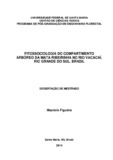| dc.creator | Figueira, Maurício | |
| dc.date.accessioned | 2015-11-10 | |
| dc.date.available | 2015-11-10 | |
| dc.date.issued | 2014-02-24 | |
| dc.identifier.citation | FIGUEIRA, Maurício. Phytosociology of tree component of the riverine forest in the river Vacacaí, Rio Grande do Sul, Brazil. 2014. 73 f. Dissertação (Mestrado em Recursos Florestais e Engenharia Florestal) - Universidade Federal de Santa Maria, Santa Maria, 2014. | por |
| dc.identifier.uri | http://repositorio.ufsm.br/handle/1/8761 | |
| dc.description.abstract | The present study aimed to analyze the tree compartment of the riverside forest in Vacacaí river and investigate the relationship between the species and the characteristics of soil and topographic variables in an environmental gradient. The regeneration, stratification and dispersion guilds for two sectors of the tree community were also analyzed.A plot of 100 x 100 m was installed in the fragment, subdivided into 100 sampling units (SU) of 10 x 10 m. Each SU has been ranked sector Upper Sites (US) or Low Sites (LS). The SUs that had good drainage were considered in US, totaling 72 SUs, and where there was evidence of possible environmental disturbances such as periodic flooding and elevation of groundwater, were classified as LS, totaling 28 SUs. All individuals with diameter at breast height ≥ 5 cm were inventoried. In each SU were collected samples of soil and topographic variables, such as elevation range and average elevation. To verify the relationships between environmental variables and the distribution of individual trees, we used the canonical correspondence analysis (CCA) was used. The survey recorded 1729 individual trees belonging to 41 species from 34 genera and 20 botany families. The species highlighted in Importance Value for the survey were Actinostemon concolor (Spreng.) Müll. Arg. (51%), Sebastiania commersoniana (Baill.) LB Sm. & Downs (46,7%), Inga vera Willd. (31%), Pouteria gardneriana (A. DC.) Radlk. (29,7%) and Casearia sylvestris Sw. (21,3%), accounting for 59,9% of this index. A canonical correspondence analysis (CCA) indicated that there is a correlation between soil and topographic variables with woody vegetation. Only four variables: the CCA were significant, average elevation, elevation range, pH and CEC. Thus, these variables stood out as good indicators of floristic and structural variations, being responsible, in part, the explanation of the formation of the two sectors. These were differences in wealth, in the structure and composition of guilds and this may be due to a different historical process of environmental change in each sector. | eng |
| dc.description.sponsorship | Coordenação de Aperfeiçoamento de Pessoal de Nível Superior | |
| dc.format | application/pdf | por |
| dc.language | por | por |
| dc.publisher | Universidade Federal de Santa Maria | por |
| dc.rights | Acesso Aberto | por |
| dc.subject | Ecologia de comunidades | por |
| dc.subject | Fitossociologia | por |
| dc.subject | Mata ciliar | por |
| dc.subject | Community ecology | eng |
| dc.subject | Phytosociology | eng |
| dc.subject | Riparian forest | eng |
| dc.title | Fitossociologia do compartimento arbóreo da mata ribeirinha no rio Vacacaí, Rio Grande do Sul, Brasil | por |
| dc.title.alternative | Phytosociology of tree component of the riverine forest in the river Vacacaí, Rio Grande do Sul, Brazil | eng |
| dc.type | Dissertação | por |
| dc.description.resumo | O presente estudo objetivou analisar o compartimento arbóreo da mata ribeirinha no rio Vacacaí e investigar a relação das espécies com as características de solo e variáveis topográficas num gradiente ambiental. Também foram analisadas as guildas de regeneração, estratificação e dispersão para dois setores da comunidade arbórea. Para o levantamento da vegetação foi instalada uma parcela de um hectare, subdividida em 100 unidades amostrais (UA) de 10 x 10 m. Cada UA foi classificada em setor Terreno Alto (TA) ou Terreno Baixo (TB). As UAs que tinham boa drenagem foram consideradas em TA, totalizando 72 UAs, e onde havia possíveis evidências de perturbações ambientais, como inundações periódicas e elevação do lençol freático, foram classificadas em TB, perfazendo 28 UAs. Todos os indivíduos com diâmetro à altura do peito ≥ 5 cm foram inventariados. Em cada UA coletou-se amostras de solo e variáveis topográficas, como cota média e desnível. Para verificar as relações entre as variáveis ambientais e a distribuição de indivíduos arbóreos, empregou-se a análise de correspondência canônica (CCA). O levantamento registrou 1729 indivíduos arbóreos, pertencentes a 41 espécies, de 34 gêneros e 20 famílias. As espécies com destaque no Valor de Importância para o levantamento foram Actinostemon concolor (Spreng.) Müll. Arg. (51%), Sebastiania commersoniana (Baill.) L. B. Sm. & Downs (46,7%), Inga vera Willd. (31%), Pouteria gardneriana (A. DC.) Radlk. (29,7%) e Casearia sylvestris Sw. (21,3%), perfazendo 59,9% do total deste índice. A ordenação das UAs nos eixos da CCA indica a existência de um gradiente ambiental no qual existe uma mudança composição de espécies e na estrutura da vegetação. Apenas quatro variáveis foram significativas na CCA, cota média, desnível, pH e CTC. Deste modo, estas variáveis se destacaram como bons indicadores das variações florísticas e estruturais, sendo responsáveis, em parte, pela explicação da formação dos dois setores. Estes setores. Estes tiveram diferenças na riqueza, na estrutura e na composição das guildas e isto pode ser consequência de um processo histórico diferenciado de alterações ambientais em cada setor | por |
| dc.contributor.advisor1 | Longhi, Solon Jonas | |
| dc.contributor.advisor1Lattes | http://lattes.cnpq.br/2401814326298046 | por |
| dc.contributor.referee1 | Higuchi, Pedro | |
| dc.contributor.referee1Lattes | http://lattes.cnpq.br/0068554244216474 | por |
| dc.contributor.referee2 | Denardi, Luciano | |
| dc.contributor.referee2Lattes | http://lattes.cnpq.br/1636928065548205 | por |
| dc.creator.Lattes | http://lattes.cnpq.br/1022600405818850 | por |
| dc.publisher.country | BR | por |
| dc.publisher.department | Recursos Florestais e Engenharia Florestal | por |
| dc.publisher.initials | UFSM | por |
| dc.publisher.program | Programa de Pós-Graduação em Engenharia Florestal | por |
| dc.subject.cnpq | CNPQ::CIENCIAS AGRARIAS::RECURSOS FLORESTAIS E ENGENHARIA FLORESTAL | por |


